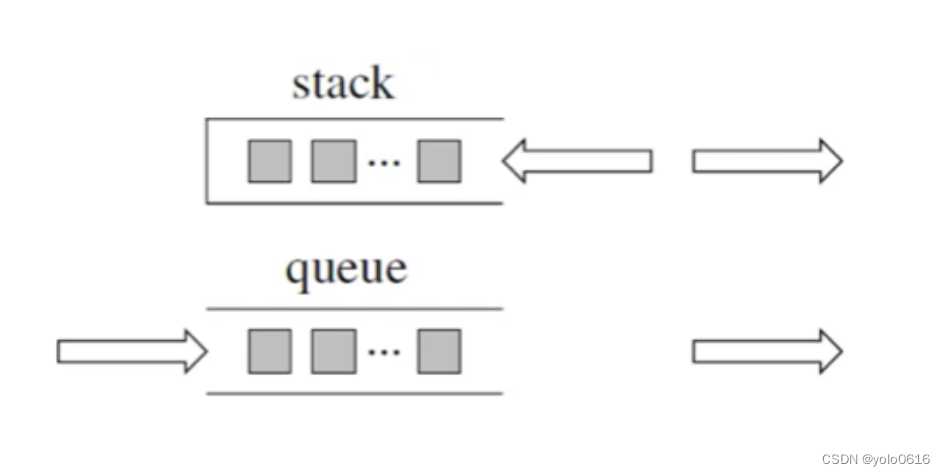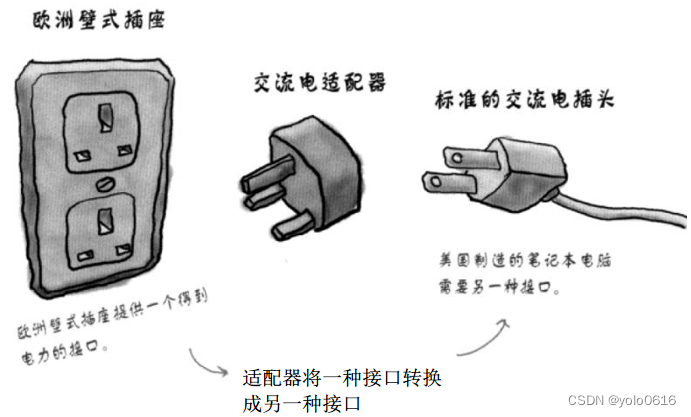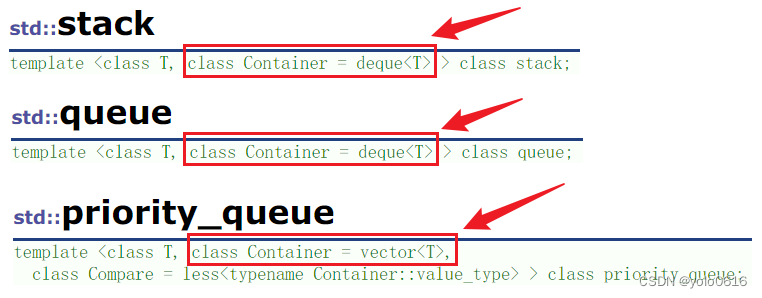-
七、栈与队列(stack and queue)
文章目录
- 一、栈与队列基础
- 二、例题
- (一)栈
- 1.[232. 用栈实现队列](https://leetcode.cn/problems/implement-queue-using-stacks/description/)
- 2.[225. 用队列实现栈](https://leetcode.cn/problems/implement-stack-using-queues/description/)
- 3.[20.有效的括号](https://leetcode.cn/problems/valid-parentheses/description/)
- 4.[1047.删除相邻有效字符 ](https://leetcode.cn/problems/remove-all-adjacent-duplicates-in-string/description/)
- 6.[150. 逆波兰表达式求值 ](https://leetcode.cn/problems/evaluate-reverse-polish-notation/)
- 7.[347. 前 K 个高频元素 ](https://leetcode.cn/problems/top-k-frequent-elements/description/)
一、栈与队列基础
队列是先进先出,栈是先进后出。

栈是以底层容器完成其所有的工作,对外提供统一的接口,底层容器是可插拔的(也就是说我们可以控制使用哪种容器来实现栈的功能)。
所以STL中栈往往不被归类为容器,而被归类为container adapter(容器适配器)。
那么问题来了,STL 中栈是用什么容器实现的?
从下图中可以看出,栈的内部结构,栈的底层实现可以是vector,deque,list 都是可以的, 主要就是数组和链表的底层实现。

虽然 stack 和 queue 和 priority_queue 中也可以存放元素,但在 STL 中并没有将其划分在容器的行列,而是将其称为容器适配器,这是因为 stack 和 queue 和 priority_queue 只是对其他容器的接口进行了包装,STL 中 stack 和 queue 默认使用 deque,而 priority_queue 默认使用 vector。
二、例题
(一)栈
1.232. 用栈实现队列
(1)思路
(2)代码
class MyQueue { public: stack<int> in; stack<int> out; MyQueue() { } void push(int x) { in.push(x); } int pop() { // 只有当out为空的时候,再从in里导入数据(导入in全部数据) if (out.empty()) { // 从in导入数据直到in为空 while (!in.empty()) { out.push(in.top()); in.pop(); } } int result = out.top(); out.pop(); return result; } int peek() { int res = this->pop(); out.push(res); return res; } bool empty() { return in.empty() && out.empty(); } };- 1
- 2
- 3
- 4
- 5
- 6
- 7
- 8
- 9
- 10
- 11
- 12
- 13
- 14
- 15
- 16
- 17
- 18
- 19
- 20
- 21
- 22
- 23
- 24
- 25
- 26
- 27
- 28
- 29
- 30
- 31
- 32
- 33
- 34
- 35
- 36
- 37
(3)复杂度分析
时间复杂度:push和empty为O(1), pop和peek为O(n)
空间复杂度:O(n)2.225. 用队列实现栈
(1)思路
(2)代码
(3)复杂度分析
3.20.有效的括号
(1)思路
(2)代码
class Solution { public: bool isValid(string s) { if (s.size() % 2 == 1) { return false; } stack<char> t; for (auto ch : s) { if (ch == '(') { // t.push(')'); } else if (ch == '[') { t.push(']'); } else if (ch == '{') { t.push('}'); } else if (t.empty() || ch != t.top()) { // 第一种情况:已经遍历完了字符串,但是栈不为空,说明有相应的左括号没有右括号来匹配,所以return false // 第二种情况:遍历字符串匹配的过程中,发现栈里没有要匹配的字符。所以return false // 第三种情况:遍历字符串匹配的过程中,栈已经为空了,没有匹配的字符了,说明右括号没有找到对应的左括号return false return false; } else { t.pop(); } } return t.empty(); } };- 1
- 2
- 3
- 4
- 5
- 6
- 7
- 8
- 9
- 10
- 11
- 12
- 13
- 14
- 15
- 16
- 17
- 18
- 19
- 20
- 21
- 22
- 23
- 24
- 25
- 26
- 27
- 28
- 29
- 30
(3)复杂度分析
- 时间复杂度: O(n)
- 空间复杂度: O(n)
4.1047.删除相邻有效字符
(1)思路
我们在删除相邻重复项的时候,其实就是要知道当前遍历的这个元素,我们在前一位是不是遍历过一样数值的元素,那么如何记录前面遍历过的元素呢?
所以就是用栈来存放,那么栈的目的,就是存放遍历过的元素,当遍历当前的这个元素的时候,去栈里看一下我们是不是遍历过相同数值的相邻元素。
(2)代码
class Solution { public: string removeDuplicates(string s) { string result; for (char ch : s) { if (result.empty() || result.back() != ch) { result.push_back(ch); } else { result.pop_back(); } } return result; } };- 1
- 2
- 3
- 4
- 5
- 6
- 7
- 8
- 9
- 10
- 11
- 12
- 13
- 14
- 15
(3)复杂度分析
时间复杂度: O(n)
空间复杂度: O(1),返回值不计空间复杂度6.150. 逆波兰表达式求值
(1)思路
那么来看一下本题,其实逆波兰表达式相当于是二叉树中的后序遍历。 大家可以把运算符作为中间节点,按照后序遍历的规则画出一个二叉树。
(2)代码
class Solution { public: int evalRPN(vector<string>& tokens) { // 力扣修改了后台测试数据,需要用longlong stack<long long> st; for (int i = 0; i < tokens.size(); i++) { if (tokens[i] == "+" || tokens[i] == "-" || tokens[i] == "*" || tokens[i] == "/") { long long num1 = st.top(); st.pop(); long long num2 = st.top(); st.pop(); if (tokens[i] == "+") st.push(num2 + num1); if (tokens[i] == "-") st.push(num2 - num1); if (tokens[i] == "*") st.push(num2 * num1); if (tokens[i] == "/") st.push(num2 / num1); } else { st.push(stoll(tokens[i])); } } int result = st.top(); st.pop(); // 把栈里最后一个元素弹出(其实不弹出也没事) return result; } };- 1
- 2
- 3
- 4
- 5
- 6
- 7
- 8
- 9
- 10
- 11
- 12
- 13
- 14
- 15
- 16
- 17
- 18
- 19
- 20
- 21
- 22
- 23
- 24
- 25
- 26
(3)复杂度分析
- 时间复杂度: O(n)
- 空间复杂度: O(n)
7.347. 前 K 个高频元素
(1)思路
首先统计元素出现的频率,这一类的问题可以使用map来进行统计。
然后是对频率进行排序,这里我们可以使用一种 容器适配器就是优先级队列。
什么是优先级队列呢?
其实就是一个披着队列外衣的堆,因为优先级队列对外接口只是从队头取元素,从队尾添加元素,再无其他取元素的方式,看起来就是一个队列。
而且优先级队列内部元素是自动依照元素的权值排列。那么它是如何有序排列的呢?
缺省情况下priority_queue利用max-heap(大顶堆)完成对元素的排序,这个大顶堆是以vector为表现形式的complete binary tree(完全二叉树)。
(2)代码
class Solution { public: class mycomparison { public: bool operator()(const pair<int, int>& a, const pair<int, int>& b) { return a.second > b.second; } }; vector<int> topKFrequent(vector<int>& nums, int k) { unordered_map<int,int> map; for (int i = 0; i < nums.size(); i ++) { map[nums[i]]++; } priority_queue<pair<int,int>,vector<pair<int,int>>,mycomparison> pri_que; for (auto it = map.begin(); it != map.end(); it ++) { pri_que.push(*it); if (pri_que.size() > k) { // 如果堆的大小大于了K,则队列弹出,保证堆的大小一直为k pri_que.pop(); } } vector<int> result(k); for (int i = k - 1; i >= 0; i--) { result[i] = pri_que.top().first; pri_que.pop(); } return result; } };- 1
- 2
- 3
- 4
- 5
- 6
- 7
- 8
- 9
- 10
- 11
- 12
- 13
- 14
- 15
- 16
- 17
- 18
- 19
- 20
- 21
- 22
- 23
- 24
- 25
- 26
- 27
- 28
- 29
(3)时间复杂度分析
时间复杂度: O(nlogk)
空间复杂度: O(n) -
相关阅读:
1.Python 设计模式
修改oem.img镜像文件
四级常见英语短语1000条
Nginx的请求时间限制(如周一到周五可以访问)
如何快速熟悉业务系统知识以及情况
Android技能树-进程-进程名称
QFramework v1.0 使用指南 工具篇:09. SingletonKit 单例模板套件
基于全卷积Fully-Convolutional-Siamese-Networks的目标跟踪仿真
君正X2100 RTOS 固件升级
多维数组的【】和多级指针*转化推演
- 原文地址:https://blog.csdn.net/weixin_54447296/article/details/133356827